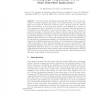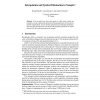104 search results - page 2 / 21 » Computing interpolants in implicational logics |
VLSID
2002
IEEE
14 years 5 months ago
2002
IEEE
Compare CMOS Logic with Pass-Transistor Logic, a question was raised in our mind: "Does any rule exist that contains all good?" This paper reveals novel logic synthesis ...
FOSSACS
1999
Springer
13 years 9 months ago
1999
Springer
Abstract. A strong (L) logic programming language ([14, 15]) is given by two subclasses of formulas (programs and goals) of the underlying logic L, provided that: firstly, any pro...
ASPLOS
2009
ACM
13 years 12 months ago
2009
ACM
This paper explores the architectural implications of integrating computation and molecular probes to form nanoscale sensor processors (nSP). We show how nSPs may enable new compu...
CADE
2010
Springer
13 years 6 months ago
2010
Springer
It has recently been shown that proofs in which some symbols are colored (e.g. local or split proofs and symbol-eliminating proofs) can be used for a number of applications, such a...
FMCAD
2007
Springer
13 years 11 months ago
2007
Springer
— Craig interpolants are often used to approximate inductive invariants of transition systems. Arithmetic relationships between numeric variables require word-level interpolants,...


